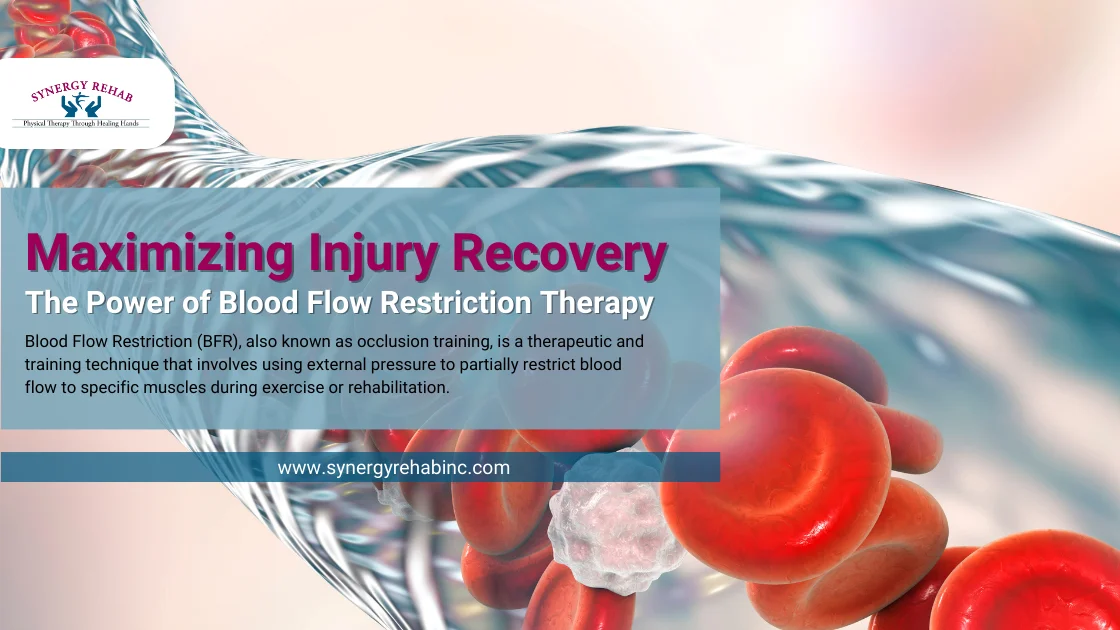
Maximizing Injury Recovery: The Power of Blood Flow Restriction Therapy
Blood flow restriction therapy (BFR) is revolutionizing the landscape of physical rehabilitation and injury recovery. This innovative technique, increasingly utilized in blood flow restriction physical therapy, offers a promising solution for those aiming to expedite their recovery process. In this article, we’ll explore the mechanics, benefits, and applications of BFR, especially in the context of injury recovery. What is Blood Flow Restriction? Blood Flow Restriction (BFR), also known as occlusion training, is a therapeutic and training technique that involves using external pressure to partially restrict blood flow to specific muscles during exercise or rehabilitation. This is typically achieved by applying tourniquets or specialized cuffs to the proximal part of the limbs, such as the upper arms or thighs. The pressure applied is carefully controlled and individualized, allowing arterial blood flow to the muscles while restricting venous return. Image Source: ONNIT The primary goal of Blood Flow Restriction is to create a hypoxic (low-oxygen) environment within the muscles being targeted. This process triggers a series of physiological responses that can lead to various benefits, especially in terms of muscle adaptation, rehabilitation, and strength development. Benefits of Blood Flow Restriction Therapy Blood Flow Restriction (BFR) therapy has gained attention and recognition for its various benefits in both rehabilitation and athletic training contexts. Some of the key benefits include: 1. Muscle Hypertrophy (Growth): BFR therapy has been shown to stimulate muscle hypertrophy, even with low-intensity resistance exercises. This is particularly valuable for individuals who may have limitations in lifting heavy weights, such as those recovering from injuries or surgeries. 2. Strength Gains: BFR allows individuals to achieve significant strength gains with lower resistance loads. This is beneficial for people who may have difficulty with traditional high-load resistance training due to injury, joint issues, or other health conditions. 3. Rehabilitation: BFR is increasingly used in rehabilitation settings to prevent muscle atrophy and promote early muscle activation. It is particularly helpful for individuals recovering from surgeries or injuries where traditional resistance training may be challenging. 4. Reduced Joint Stress: The use of lower resistance loads in BFR places less stress on the joints compared to traditional high-load resistance training. This makes it a potentially safer option for individuals with joint issues or those recovering from joint-related injuries. 5. Pain Management: BFR therapy has shown promise in managing pain, especially in conditions like osteoarthritis. The localized metabolic stress induced by BFR may contribute to pain relief and improved joint function. Types of Injuries Treated with BFR Blood Flow Restriction (BFR) therapy is utilized in the treatment of various injuries, particularly in the field of rehabilitation. Some types of injuries that may benefit from BFR therapy include: 1. Muscle Injuries: BFR is commonly used in the rehabilitation of muscle injuries, such as strains and tears. By promoting muscle activation and growth with lower-intensity exercises, BFR helps prevent muscle atrophy and accelerates the recovery process. 2. Post-Surgical Rehabilitation: BFR is frequently incorporated into post-surgical rehabilitation programs, especially after procedures involving joints or muscles. It helps maintain muscle mass and function during the initial stages of recovery when traditional high-load resistance training may be limited. 3. Joint Injuries: BFR therapy may be applied in cases of joint injuries, such as ligament sprains or cartilage damage. The ability to achieve muscle activation with lower resistance loads minimizes stress on the affected joint while still promoting strength and stability. 4. Fracture Recovery: Individuals recovering from fractures may use BFR therapy to maintain muscle strength and function during the immobilization period. It provides a means of exercise that doesn’t put excessive strain on the healing bone. 5. Nerve Injuries: BFR therapy may be considered in cases of nerve injuries or neuropathies. The controlled blood flow restriction allows for targeted exercises to stimulate muscle activation without causing additional stress on the affected nerves. Blood Flow Restriction Therapy in Physical Therapy Blood Flow Restriction (BFR) therapy is emerging as a revolutionary technique in physical therapy, complementing traditional rehabilitation methods. Offered by physical therapists in Southfield, this approach involves applying a specialized tourniquet to an injured limb, reducing blood flow and creating a low-oxygen environment in the muscles. This unique condition enables muscle strengthening and growth at lower exercise intensities, ideal for patients unable to perform high-load workouts due to injury or post-surgery limitations. BFR therapy, as provided by the best physical therapists in Southfield, offers significant benefits, including accelerated muscle strength gains, enhanced endurance, and quicker recovery times, without the stress of intense exercises. Image Source: Freepik Conclusion Blood Flow Restriction (BFR) Therapy represents a significant evolution in the field of injury recovery and physical rehabilitation. Its unique methodology, skillfully combining low-intensity exercise with restricted blood flow, provides a route to expedited recovery, enhanced muscle strength, and improved rehabilitation outcomes, all without the strain of high-load exercises. This inventive technique proves beneficial not just for athletes and individuals recovering from surgeries but also serves as a valuable asset for those facing limitations due to chronic conditions or age-related muscle loss. For those seeking to incorporate this cutting-edge therapy into their recovery process, Synergy Rehab Inc. offers expert guidance and personalized care. Embrace the power of Blood Flow Restriction Therapy with the professionals at Synergy Rehab and step into a world where optimal recovery is not just a goal, but a reality. Visit our website to learn more and to schedule your appointment. Let’s work together to maximize your injury Frequently Asked Questions Q1: What is Blood Flow Restriction Therapy (BFR)?Blood Flow Restriction Therapy is a rehabilitation technique where a cuff or tourniquet is applied to restrict blood flow to the limbs during low-intensity exercise, promoting muscle strength and hypertrophy with reduced stress on tissues. Q2: How does Blood Flow Restriction Therapy enhance recovery? Blood Flow Restriction Therapy at Synergy Rehab accelerates recovery by allowing significant muscle growth and strength benefits from lower-intensity workouts, making rehabilitation more efficient and effective. Q3: What benefits does Blood Flow Restriction Therapy offer? BFR benefits include quicker recovery times, restoration of muscle function, and improved cardiovascular health, even



